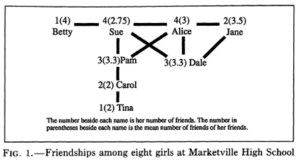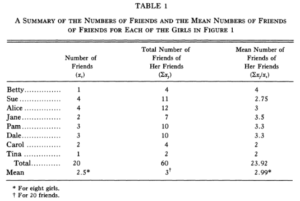The friendship paradox is the phenomenon that entails your friends having on average more friends than you do! From a high-level perspective, one reason behind this is because people that who have many friendships will be disproportionately apparent in multiple sets of friends, whereas the friends these popular people will be dwarfed by the friend count of their popular friends. I chose this topic because I wanted to see if it could be personally applicable to me and my friend groups. An interesting note is that I have two primary friend groups; one from University, and one from back in High School.

In the figure above, a group of high school students was studied to research this phenomenon. From this, we can gather a few facts. Betty’s friend Sue has a greater amount of friends than Betty does. Jane’s friends also average more friends than Jane. Dale’s three friends also have more friends on average than Dale. Of these eight students, only 2 have more friends than average than their peers, whereas 5 of them have fewer friends on average.

In this table, we can see that on average, most students’ friends have more friends than them.
Conclusion
This type of phenomenon is something weirdly interesting to study, however, it would be hard to understand this data without a visualization provided by graphs, thus implying that graph theory has many real-world applications that can help us with analyzing data.
Sources
https://www.journals.uchicago.edu/doi/10.1086/229693 (Need UTORID login to view pdf)